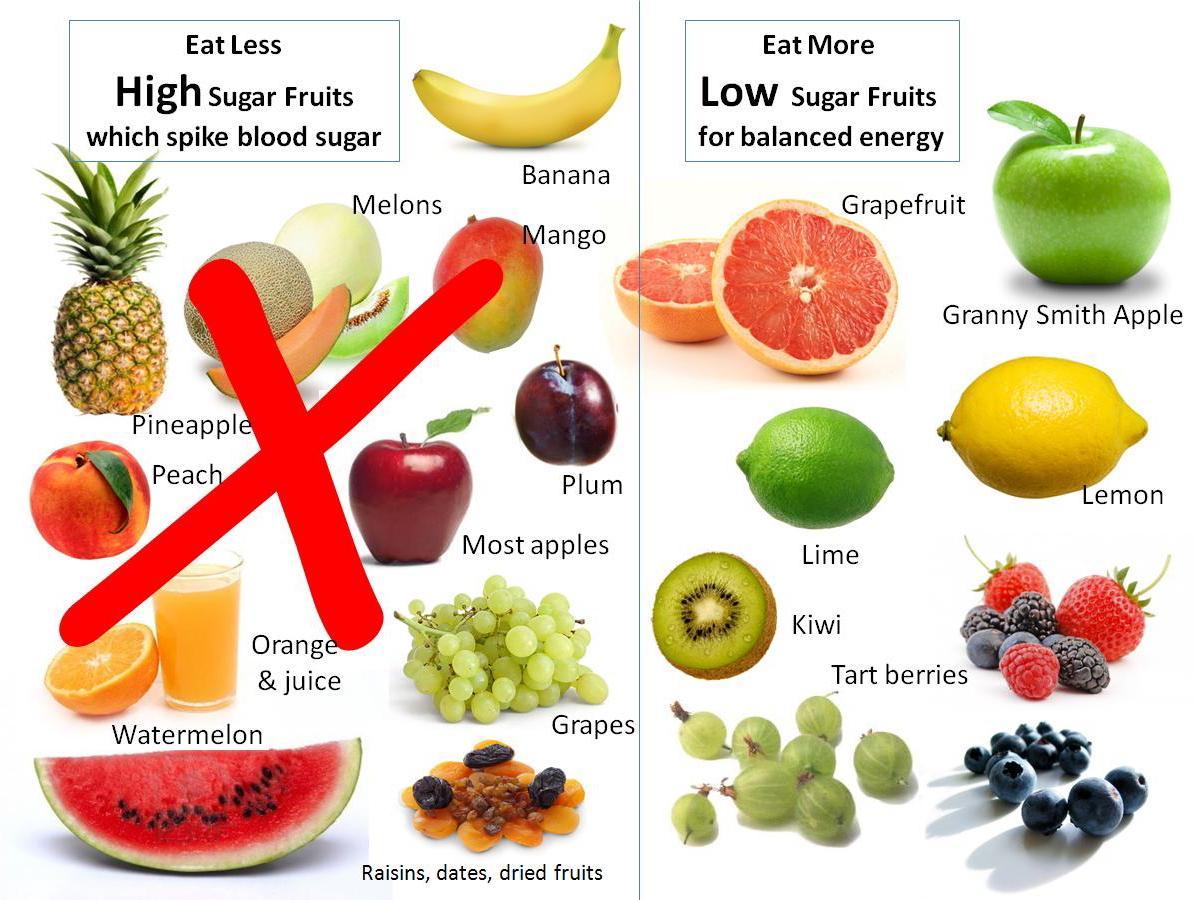We used to consider all fresh fruits healthy. But high-sugar fruits can be toxic to the liver. Fructose has been getting a bad rap lately. Dr. Mercola calls it a “poison”, Dr. Robert Lustig says it’s a “liver toxin”, and Dr.Oz. calls it a “hidden sugar”. The best guideline is to limit yourself to 20 grams fructose per day. That’s 4.5 teaspoons, or the sweetness in two apples.
What is Fructose?
Fructose is a natural sugar found in fruits and vegetables. Pure fructose is about 70% sweeter than sugar. Fructose can be granulated like table sugar. Or it can be in liquid syrup form such as agave nectar, coconut syrup, honey and high fructose corn syrup (HFCS). High-fructose corn syrup has also been getting a lot of bad publicity lately. Some say that good old-fashioned sugar is healthier than HFCS. Oh how I wish it were true, but unfortunately it is not. Both Fructose and Sucrose are harmful
Fructose has a lower glycemic index than sugar, and that is GOOD! (Glycemic index measures glucose, not fructose) However, because it is metabolized in the liver, fructose is actually a liver toxin. The liver can only metabolize small amounts of fructose per day: about 20 grams, or 4.5 teaspoons. Over-consumption of fructose can cause slower metabolism and de-novo lipogenesis, or the conversion of sugar into high cholesterol fats. Eeek! We eat natural fructose in fruits, and when it’s surrounded by fiber the sugar absorption rate is slower. This is nature’s way of protecting us from fructose. But when we extract concentrated fructose and consume it in quantity every day, it can create big problems.
Sources of Fructose:
1. Refined fructose, or High Fructose Corn Syrup, is found in many soft drinks, packaged and prepared foods, breakfast cereals, candy, fruit drinks, energy bars, donuts, and even gluten-free sweets.
2. Natural fructose sources are fruit juices, raisins, dates, figs, prunes, grapes, mangos, papayas, apricots, pineapples and bananas. These are the super-sweet fruits to reduce or avoid eating. Apple and grape juice sweetened foods are high in fructose. Most people consider fruit juice healthy, however juices are extracted sweetness without the fiber, and they’re loaded with fructose. Fruit juices and soft drinks are are equally high in fructose. Just one glass of fruit juice contains 20 – 30 grams fructose, which is over the daily limit of 20 grams! See the diagram below showing fruits to eat and fruits to avoid.
Fruits to Eat Less or Avoid vs. Fruits to Eat:

What are the Dangers of Fructose?
Fructose in large quantities can cause big problems. It increases the risk of hypertension (high blood pressure) and type 2 diabetes. It can raise total blood cholesterol levels, LDL-“bad” cholesterol levels, and triglyceride levels, especially in diabetics. It can cause fatigue, insulin resistance and obesity. It can cause fructose intolerance (DFI), which is a condition said to be found in nearly one third of the population, meaning they are unable to completely absorb fructose. This, in turn, can cause flatulence, intestinal cramps, bloating, abdominal pain, and diarrhea. Fructose may cause symptoms of irritable bowel syndrome (IBS) and can be an underlying cause of some types of IBS, due to poor absorption of fructose.
Fructose has a High Conversion to Fat. When we eat fructose or HFCS, 30% of it is converted to fats! The fats created are low-density lipoproteins, VLDL’s, or the bad cholesterol fats.
Fructose is linked to an increase in uric acid levels. The biochemical breakdown of fructose in the liver produces uric acid as a waste product, which is a primary cause of gout, a type of arthritis. Uric acid is linked to high blood pressure and hypertension. In a recent study it was found that lowering uric acid levels actually successfully reversed hypertension. Could our epidemic of hypertension be linked to increased fructose consumption?
What are the fructose levels in some common fruits?

Fructose in Modern Times vs. Paleolithic Times:
The average American adolescent male is said to consume 75 grams of fructose per day – way over the suggest limit of 20 grams! Our Paleo ancestors ate far less fructose than we do today. The delicious fruits that we buy in modern times have been selected and bred over thousands of years to be sweeter and sweeter, since that’s what we love. Paleolithic apples are said to be akin to our tartest crab apples. That’s why the Paleo Diet includes tart fruits, but eliminates sweet fruits. Use the charts above to try measuring your fructose consumption for a few weeks, and notice how you feel. It could be a life-changing step into a healthy, balanced metabolism! The graph below shows the change in fructose consumption in recent years.
Frutose Consumption per Capita in the USA, 1961 to 2000, and Obesity Trends.
“Fructose is a liver toxin like alcohol. It can promote high cholesterol, insulin resistance, fatty liver deposits, inflammation and can lead to diabetes. Fructose is a metabolic disaster in the human body. It provokes cravings to eat more and more in a vicious cycle of consumption and disease in our society.”
“Fructose, Glucose and all Sugars are Health Hazards. Fructose causes the liver to overwork. Glucose causes insulin levels to spike, leading to insulin resistance, type-2 diabetes and obesity. There are no healthy high sugar foods.” Dr. Robert H. Lustig, MD, author of “The Bitter Truth” Video, Professor of Pediatrics in the Division of Endocrinology at U of C in San Francisco.
Fruit juices and soft drinks are major hidden sources of fructose.










